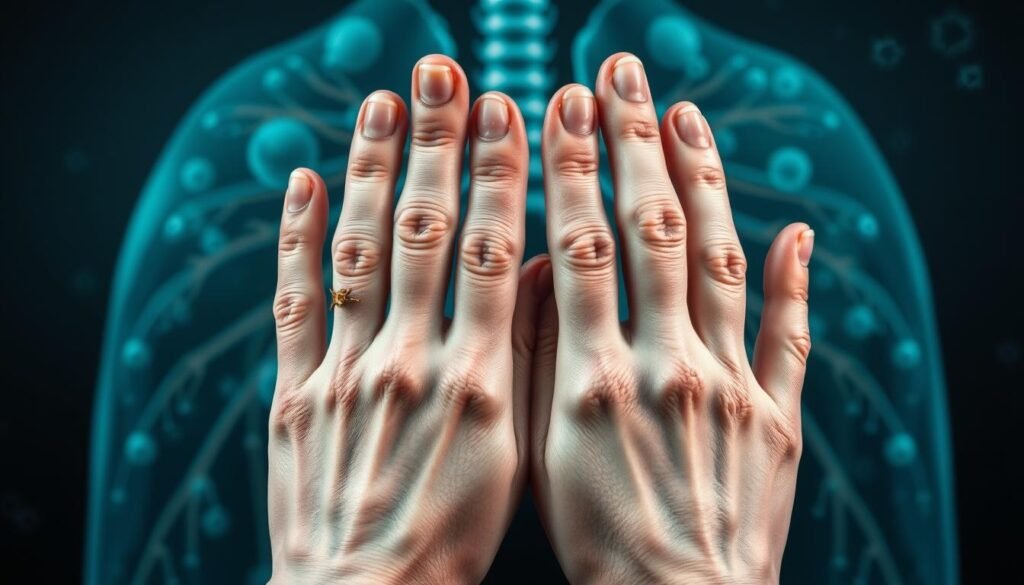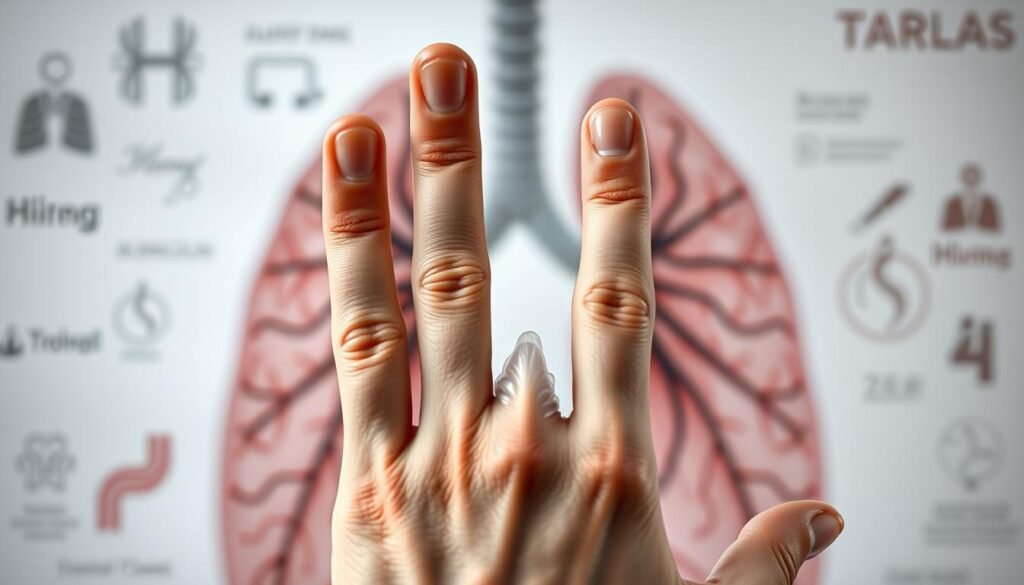Did you know that around 80% of people with finger clubbing have lung cancer? This fact points out the link between the two conditions. Finger clubbing involves the fingertips getting bigger and nail shape changing. It’s a key sign of health issues, often lung or heart problems. Finger clubbing can alert us to lung cancer and mesothelioma early on. Our goal is to explore how finger clubbing and lung cancer are connected. We’ll look at finger clubbing’s symptoms and highlight why catching it early matters for treatment success.
Key Takeaways
- Finger clubbing can indicate serious health issues, especially lung problems.
- It is crucial to recognize finger clubbing as a potential sign of lung cancer.
- Early diagnosis greatly improves treatment options and outcomes.
- Awareness of symptoms alongside finger clubbing can lead to timely medical intervention.
- Not all finger clubbing is permanent; its duration can depend on the underlying cause.
What is Finger Clubbing?
Finger clubbing is when changes happen in the fingers and nails making them round and broad. This condition shows through a more rounded and bigger fingertip. It changes how the fingers look. Understanding its stages helps spot different health issues.
Definition and Overview
The definition of finger clubbing is when the end of the fingers swell. This causes changes in the shape of the fingers and nails. It’s linked with diseases, mainly in the lungs. Lung cancer causes nearly 80% of these cases. It also appears with celiac disease, liver cirrhosis, and heart defects. This shows its wide range of causes.
Stages of Finger Clubbing Development
The stages of finger clubbing include:
- Stage 1: The area around the nail bed softens and might turn red.
- Stage 2: There’s a bigger angle where the nail meets the skin, making it curve more.
- Stage 3: The nails become shiny and ridged, with fingertips getting much larger.
In cases like lung abscesses, finger clubbing can happen fast, within weeks. Quick assessment is key to find and treat any serious health problems. For more info on finger clubbing, check out this guide.
Understanding Finger Clubbing and Lung Cancer
Finger clubbing is closely linked to lung cancer. It’s a key sign that may suggest more serious health problems, like lung cancer. About 5% to 15% of people with lung cancer show symptoms of finger clubbing. This happens when changes in blood flow cause cells to expand in the fingertips, leading to abnormal growth.
The Connection Between the Two Conditions
Finger clubbing can happen with different health issues, not just lung cancer. As lung cancer gets worse, it can change the appearance of fingers and nails. People with normal nails have a Lovibond angle less than 180 degrees. But with clubbing, the angle is more. This helps doctors spot lung cancer early on.
Statistics on Finger Clubbing in Lung Cancer Patients
Learning about finger clubbing in lung cancer patients shows us how common it is. Many lung cancer patients quit smoking by themselves just before being diagnosed. It highlights how important it is to notice symptoms like finger clubbing. By looking at the hyponychial angle and phalangeal depth ratios, doctors can tell a lot about your lung health.
The hyponychial angle in healthy people is usually less than 192 degrees. But it’s more in those with clubbing. A phalangeal depth ratio under 1 means no clubbing, but a higher number suggests clubbing. Knowing these stats helps patients and doctors keep an eye on lung health.
Finger Clubbing Symptoms
Finger clubbing symptoms show through clear visual signs. These signs suggest changes in the nails and fingertips. Spotting these signs early helps in recognizing possible health problems quickly.
Visual Signs of Clubbing
People with finger clubbing might notice several key features in their fingertips. These are:
- Swelling around the fingertips, giving them a rounded appearance.
- Warmth and increased redness in the fingers.
- An unusual curvature of the nails, making them appear larger and changing their typical shape.
- The skin surrounding the nails may appear shiny and smooth.
Noticing these signs of clubbing can lead to further checks. This is especially important if there’s a chance it’s related to lung cancer.
Changes in Nail Characteristics
The changes in nail features are key to spotting finger clubbing symptoms. Clinically important details include:
- Lovibond angle: The angle between the nail bed and the nail itself.
- Hyponychial angle: This measures the angle formed by the tip of the nail where it detaches from the nail bed.
Changes in curvature and angles help in diagnosing finger clubbing. It’s critical to link these nail changes to conditions like lung cancer for managing patient health.
Causes of Finger Clubbing
Finger clubbing often points to serious health concerns. It usually relates to problems with the lungs or heart. Knowing what leads to digital clubbing helps in understanding its importance.
Potential Underlying Health Conditions
The main health issues tied to finger clubbing include:
- Lung cancer, accounting for a significant portion of clubbing cases.
- Interstitial lung disease and pulmonary fibrosis.
- Cystic fibrosis and bronchiectasis.
- Cardiovascular anomalies, especially cyanotic congenital heart disease (CCHD).
- Liver cirrhosis and thyroid disorders, though these are less common.
About 80% of clubbing cases stem from lung problems. It also shows how various diseases can lead to finger clubbing.
The Role of Megakaryocytes
Megakaryocytes are key in making blood platelets. They might get stuck in the small vessels of fingers. This leads to growth factors being released.
Such growth factors cause more blood vessels to form. Swelling happens, and fingers start to look clubbed.
| Health Condition | Prevalence in Clubbing |
|---|---|
| Lung Cancer | 80% |
| Interstitial Lung Disease | Moderate |
| Ulcerative Colitis | Less Common |
| Cyanotic Heart Disease | Moderate |
| Liver Cirrhosis | Rare |
Treating the underlying health problems is key to manage clubbing. Options include chemotherapy and surgery. This helps lessen the clubbing.
Lung Cancer Diagnosis
It’s key to spot lung cancer signs early for quick care. Patients show symptoms needing fast check-up. Knowing these can catch lung cancer sooner, boosting treatment success.
Signs Prompting Medical Consultation
People should watch for signs of lung problems. Key symptoms are:
- Persistent cough that doesn’t go away
- Unexplained fatigue
- Shortness of breath
- Chest pain or discomfort
- Changes in nails, such as finger clubbing
Don’t ignore these signs. They might mean you need more tests for lung cancer, especially early on.
Diagnostic Tests for Lung Cancer
Doctors use several tests to check for lung cancer. These tests are:
| Test | Description |
|---|---|
| Chest X-ray | A quick imaging test to visualize the lungs. |
| CT Scan | Detailed cross-sectional images providing a more comprehensive view. |
| Biopsy | A sample of lung tissue examined for cancerous cells. |
These tools are crucial for diagnosing lung cancer and planning treatment.
Importance of Early Detection
Spotting lung cancer early is very important. It boosts survival chances and treatment success. Lung cancer causes lots of deaths; nearly 132,000 in the U.S. in 2021. Early diagnosis means better treatment options and outcomes.
Hypertrophic Pulmonary Osteoarthropathy
Hypertrophic pulmonary osteoarthropathy (HPOA) is rare. It shows up in people with certain lung diseases, like lung cancer. This disease creates extra bone at the joints. Detecting and treating it is challenging. It’s often seen with finger clubbing, which connects these conditions.
What is Hypertrophic Pulmonary Osteoarthropathy?
HPOA starts when lung problems cause too much soft and bone tissue to grow. It’s found in about 5% of lung cancer patients. This shows it’s rare but clinically significant. Those with HPOA may have joint pain and swollen legs. This can make diagnosis hard because it looks like arthritis. VEGF seems key in HPOA, linking tumor growth to this extra tissue.
Diagnosis and Symptoms
Spotting pulmonary hypertrophic osteoarthropathy can be tough. It often gets confused with other problems. Common symptoms include:
- Digital clubbing
- Joint pain
- Swelling in the legs
Diagnosis demands careful checking and sometimes bone scans. A study found 1.87% of lung cancer patients had HPOA signs. This link with lung cancer means it needs serious attention.

Treating HPOA focuses on the main lung disease. Pain relief and bisphosphonates help reduce inflammation and pain. This betters patient life. More research, like on lung cancer and hypercalcemia, can offer extra info.
Risk Factors for Lung Cancer
It’s crucial to know what makes lung cancer more likely. Many things can increase your risk, like where you live and what you do. If you’re aware, you can take steps to lower your risk of getting lung cancer.
Common Risk Factors
There are several key lung cancer risk factors everyone should be aware of:
- First-hand smoking: This is the top cause. About 74% of people surveyed know it’s a big risk.
- Second-hand smoke: This is also dangerous, with 68% recognizing its risk.
- Environmental toxins: Bad substances in your environment can cause lung cancer. About 62% of people are aware of this.
- Genetic predispositions: Your family’s health history can affect your risk. Awareness varies among different groups.
Impact of Lifestyle Choices
Lifestyle has a big impact on who gets lung cancer. What you eat, how much you move, and if you smoke or not all play a part. Making better lifestyle choices can lower the risks that come from smoking and bad environments. By making smart changes, you can improve your health for the long term. Learn more about these risk factors by clicking here.
| Risk Factor | Acknowledgment Percentage |
|---|---|
| First-hand smoking | 74% |
| Second-hand smoke | 68% |
| Environmental toxins | 62% |
| Genetic predispositions | Varies |
Being aware of how lifestyle choices affect lung cancer is key. Knowing the symptoms of lung cancer and signs like finger clubbing is essential for getting help early.
Paraneoplastic Syndrome and Finger Clubbing
Paraneoplastic syndrome is a group of symptoms indirectly caused by a tumor. These symptoms affect organs far from the tumor. They are noteworthy in lung cancer patients, leading to symptoms like finger clubbing.
What is Paraneoplastic Syndrome?
This syndrome includes various effects linked to cancers, especially lung cancer. It can lead to hormonal issues, electrolyte imbalances, and neurological problems. Around 10% of lung cancer patients show these symptoms. They help doctors understand the cancer better and can warn of a tumor.
Link Between Lung Cancer and Paraneoplastic Symptoms
Lung cancer can cause symptoms like high calcium levels and finger swelling. Finger swelling, or digital clubbing, is mostly found in non-small cell lung cancer. High calcium levels are diagnosed in 2%-6% of lung cancer cases at the start, rising to 8%-12% as the disease progresses. This often comes from a condition called humoral hypercalcemia of malignancy (HHM), seen in 46%-76% of lung cancers.

Successfully treating the cancer can quickly fix clubbing and other symptoms. Spotting these symptoms early is crucial. It could mean the lung cancer is still treatable, allowing for faster medical help.
| Paraneoplastic Symptom | Associated Cancer Type | Incidence Rate |
|---|---|---|
| Digital Clubbing | Non-Small Cell Lung Cancer | Common |
| Hypercalcemia | Squamous Cell Carcinoma | Up to 23% |
| Hypokalemia | Small Cell Lung Cancer | Rare |
| Syndrome of Inappropriate Antidiuretic Hormone Production | Small Cell Lung Cancer | Common |
| Cushing’s Syndrome | Various Lung Cancers | Uncommon |
Learning about these links helps doctors and patients spot early signs. This can lead to faster diagnosis and better chances of recovery.
Finger Clubbing Treatment Options
Treatment for finger clubbing focuses on the root cause. It’s very important because finger clubbing might signal serious illnesses, like lung cancer. Treating lung cancer can lessen clubbing symptoms.
Focusing on Underlying Conditions
To manage finger clubbing, the treatment looks at the exact cause. For lung cancer patients, the treatments might be:
- Surgery to remove tumors
- Chemotherapy to fight cancer growth
- Radiation therapy to make tumors smaller
Each cancer type and stage may need a different approach. Besides cancer, other lung issues might need drugs and lifestyle adjustments.
Importance of Medical Intervention
Getting medical help fast is key to treating finger clubbing. Early action is vital to improve health and life quality.
If you have signs of COPD or finger clubbing, see a doctor soon. Knowing how clubbing connects to other health problems helps you get the right treatment.
| Treatment Method | Target Condition | Key Benefits |
|---|---|---|
| Surgery | Lung Cancer | Reduces tumor burden |
| Chemotherapy | Lung Cancer | Inhibits cancer cell growth |
| Radiation Therapy | Lung Tumors | Targets specific areas for healing |
| Oxygen Therapy | Chronic Lung Conditions | Improves oxygen levels in the blood |
| Pulmonary Rehabilitation | General Lung Health | Enhances lung function and endurance |
Watch and Wait Approach
The watch and wait approach is a way doctors keep a close eye on a patient without starting treatment right away. It’s used when symptoms are not severe or the cause of a problem is unclear. For example, if a patient shows signs of finger clubbing, which might indicate lung cancer, this method allows doctors to watch for any changes. This helps them decide if or when treatment is needed.
Understanding the Approach
This method balances carefully watching a patient and stepping in when necessary. It avoids the downsides of immediate treatment, like side effects. Doctors watch the patient’s vital signs, symptoms, and overall health. This approach helps them spot trends that might call for more urgent steps if the patient’s health changes.
When is it Appropriate?
This strategy is best when the danger of a disease getting worse is low. It’s suitable for cases like suspected finger clubbing from lung cancer, but with mild symptoms. Continuous monitoring lets doctors figure out the right time for treatment. Talking about lifestyle changes and getting regular medical advice can also help during this time. For more info on lung cancer and how to manage symptoms, check out the Macmillan Cancer Support booklet.

Early Detection of Lung Cancer
Finding lung cancer early is key to beating it. Getting checked often is how you spot early signs. These checks can spot things like finger clubbing, a subtle but critical symptom. It’s important for everyone to take steps to prevent cancer early on.
Importance of Routine Check-Ups
Going for regular check-ups helps find lung cancer early. The value of these check-ups is huge. They can uncover early signs that could mean cancer. Knowing these signs early can make a big difference in treatment choices.
Self-Examination and Monitoring Changes
Checking yourself is vital for catching lung cancer early. Be aware of symptoms like ongoing coughs, feeling weak, or other changes. Noticing even small changes can help catch cancer early. This helps you get the help you need quicker.
| Symptom | Significance |
|---|---|
| Persistent Cough | Often an early indicator of lung issues. |
| Weight Loss | May suggest underlying problems, including cancer. |
| Fatigue | Common in lung cancer, often resulting from anemia. |
| Finger Clubbing | Indicator seen in many lung cancer patients; critical for diagnosis. |
Conclusion
Finger Clubbing and Lung Cancer are deeply linked, pointing to serious health issues. This condition appears in 80% of people with lung cancers. It tells us how vital early detection is. Knowing symptoms like constant cough, chest pain, and losing weight without trying matters. It helps people seek medical advice sooner.
Smoking greatly increases lung cancer risk. Quitting smoking cuts this risk after five years. But, former heavy smokers stay at high risk. Thus, regular check-ups are critical, especially for those 55 to 74 who smoked a lot. Screenings like scans and lung tests help find issues early.
Talking about finger clubbing raises awareness of lung health. It shows the need for early spot and action on lung issues. For details on early signs, check this resource. Focusing on lung health leads to better treatments and life quality.